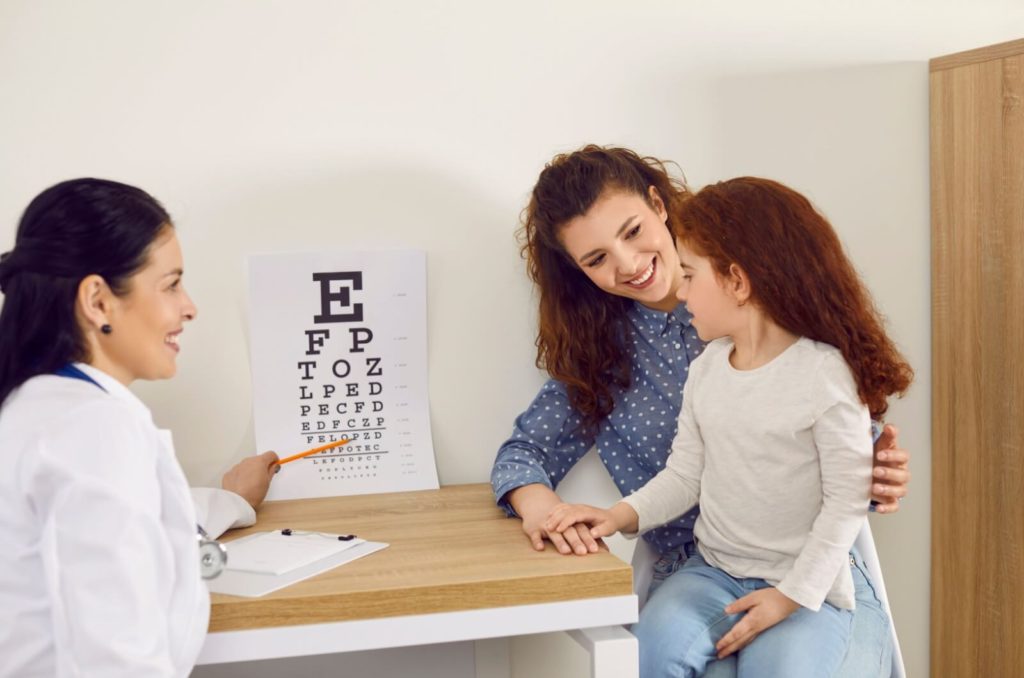While vision problems can affect people of all ages, nearsightedness (myopia) is a common refractive error that often begins in childhood and can worsen over time. Myopia is often corrected with glasses, contact lenses, or laser eye surgery. Still, it can increase the risk of certain eye diseases later in life, so many people wonder if it can be reversed.
Unfortunately, there’s no cure for myopia, but myopia control can help slow its progression in children. Regular eye exams help diagnose myopia early, allowing for timely management.
What Is Myopia?
Myopia is not a disease or condition but a variation of normal. It occurs when the eye grows too long, or the cornea (the clear dome of the eye) is too curved, causing light to focus in front of the retina instead of on it. This causes blurry distance vision.
Myopia results from a combination of genetic and environmental factors.
Children with one or more nearsighted parents are more likely to be nearsighted themselves. However, lifestyle factors can also contribute. Close tasks like reading and screen use, which require intense focus on nearby objects for prolonged periods, increase the risk of developing myopia.
Limited outdoor activity has also been linked to a higher risk of myopia progression. Increasing time outdoors and exposure to natural light promotes healthier eye development.
Myopia often begins developing between ages 6 and 12 and can progress throughout their teens years and into early adulthood. It is important for parents to monitor their children’s vision and address any concerns with their eye doctor. Regular eye exams can detect myopia and allow for early intervention, which can slow down its progression.
Myopia & Eye Health: A Closer Look
The severity of myopia is measured in diopters. A lower diopter value indicates milder nearsightedness, often requiring lower prescriptions and typically progressing at a slower rate. Someone with mild myopia may only need glasses to drive or watch TV. However, there is no safe level of myopia. Even mild nearsightedness can increase the risk of developing serious eye conditions later in life.
As myopia worsens, the risk of eye problems increases exponentially. Generally, prescriptions of -6D or higher are considered high myopia, which requires stronger corrective lenses. Studies have shown that individuals with high levels of myopia are more likely to experience vision-threatening conditions such as retinal detachment, glaucoma, and cataracts.
It’s important to take proactive steps to manage myopia early to help protect your child’s future vision. By implementing myopia control strategies while the eyes are still growing, we can reduce the risk of eye health complications.
Myopia can’t be reversed once it has developed, so if you’re an adult with myopia, make sure to see your eye doctor regularly to monitor your eye health. Routine eye exams can help identify any potential issues early on and ensure that you’re using the most appropriate corrective lenses.

Personalized Options for Myopia Control
There are several effective myopia control strategies available, each utilizing different mechanisms to slow the progression of nearsightedness. While the specific approach that works best will vary from child to child, the common goal is to reduce the likelihood of developing severe myopia and its associated complications.
At The Eye Care Team, we offer myopia control treatment:
- Myopia-slowing eyeglasses: These lenses feature a special design that uses defocus technology to reduce the blurriness experienced by myopic eyes.
Myopia & Astigmatism
Nearsightedness and astigmatism are 2 different refractive errors, but they often occur together.
Both refractive errors occur due to irregular shapes. While myopia is caused by an elongated eye or a steeply curved cornea, astigmatism occurs when the cornea or lens is more oval than round.
Myopia affects distance vision, whereas astigmatism causes blurry or distorted vision at all distances.
Like myopia, astigmatism can be corrected with eyeglasses, contact lenses, or surgery. Toric lenses are designed for people with both astigmatism and myopia.
Laser Eye Surgery
For people over 18, laser eye surgery can help correct nearsightedness, farsightedness, and astigmatism.
To see if laser eye surgery is a good fit for you, your eye doctor will need to examine your eyes and discuss any concerns you may have. These procedures can help you reduce your reliance on glasses or contacts. However, your vision may change as you get older, so you might still need glasses at some point after surgery.
LASIK is the most common type of laser eye surgery. It involves creating a thin flap on your cornea, lifting it, and using a laser to reshape the tissue underneath. Then, the flap is put back in place to heal.
PRK is another option that doesn’t require a flap. Instead, the top layer of your cornea is removed, and the laser reshapes the tissue below. A bandage contact lens is then placed on the eye’s surface to help it heal.
A Clear Path to Clearer Vision
Whether you are looking for information on myopia control for your child or looking at refractive surgery options for yourself, we’re here to help. Our dedicated eye care professionals at The Eye Care Team are committed to delivering personalized care. We believe in empowering our patients with the knowledge and tools they need to maintain healthy eyes and enhance their quality of life. Contact us today to schedule an appointment.



